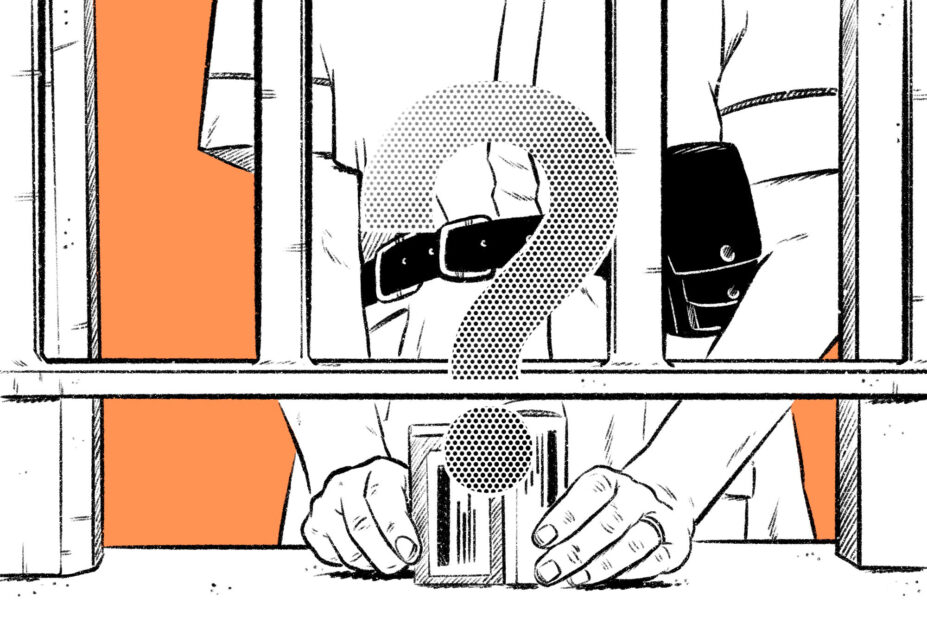
Wes Mountain/The Pharmaceutical Journal
This case example explores the difficulties of switching between brands of clozapine in a prison setting.
A list of the skills, mapped to the Royal Pharmaceutical Society’s ‘Competency framework for all prescribers’, required to manage such situations can be found at the end of this article.

Case presentation
A 26-year-old male patient presented to prison from court at 16:00 on a Friday, after the psychiatrist had left for the weekend. The patient has a diagnosis of treatment-resistant schizophrenia and takes Clozaril (clozapine; Mylan) 150mg twice daily to treat this.
The patient was reviewed upon arrival, with a full medication history and mental state examination conducted. He was well orientated to the time and place, demonstrated good insight and was able to ask and answer questions appropriately. The patient said that he was compliant with his medication and had taken his 150mg dose of Clozaril that morning and was due a 150mg dose in the evening.
The patient’s bloods were most recently taken one week ago (with a GREEN result, meaning his blood results were in range and he was fine to continue taking the medication) and his next blood tests were due three weeks from now.

The dilemma
The patient did not bring his Clozaril with him and did not have anyone who could bring the medication to the prison. Additionally, the prison policy at the time stated that all patients must be on the Zaponex brand of clozapine (Leyden Delta BV) rather than the Clozaril brand, which meant that only Zaponex was kept on site and not Clozaril.
The patient could not be switched from Clozaril to Zaponex without being transferred to the Zaponex and Treatment Access System (ZTAS), the report from which the prison pharmacist would need to wait for1. This would ensure that the data from the previous blood monitoring system corresponded to what the patient reported and that it was safe to administer medication. If there was a discrepancy in report and the patient was administered the medication, there could be a possibility of clozapine toxicity or sub-therapeutic treatment, potentially resulting in relapse of mental state2.
If a patient does not take their prescribed clozapine for 48 hours, they must be re-titrated1. As it was near the end of the day on a Friday, this presented a dilemma where, unless the pharmacist intervened, there was a strong chance that the patient would not receive their medication and would have to experience a treatment break. In a treatment break, the patient would likely lose tolerance to many of the dose related side-effects of clozapine, such as sedation, tachycardia and postural hypotension. If the full treatment dose is taken after tolerance is lost, the patient may have felt very unwell and would be at high-risk of seizures, tachycardia, hypotension and circulatory collapse, which would subsequently require re-titration2.

Initial plan
The pharmacist contacted the ZTAS monitoring system promptly and raised awareness of the patient’s location and requested the transfer from Clozaril to Zaponex through the system, and waited for further advice. The pharmacist encouraged ZTAS to process the request as fast as possible (although ZTAS has changed its online manual stating to re-titrate only after 72 hours)3.
While the transfer was taking place, the pharmacist explained to the nurse that there was a possibility of no medication being supplied that evening. If this were the case, they explained that the patient would need to be monitored for any deterioration in their mental state, alongside baseline checks of blood pressure, heart rate and weight. This advice was in accordance with Oxleas NHS Foundation Trust’s clozapine policy.
The patient was also added to phlebotomy list for urgent bloods to be taken the next working day and informed of the actions taken. He was understanding throughout.

Outcomes
ZTAS promptly actioned the request because it had access to the patient’s latest blood test results while taking Clozaril, which had confirmed a ‘GREEN’ result. The pharmacist was subsequently given permission to safely medicate the patient that day.
As there was no psychiatrist available, Zaponex 150mg was prescribed twice daily for the next seven days by the pharmacist, which safety-netted the patient over the weekend and provided time for a psychiatrist to review the patient the following week. The GP attending to all new people entering prison that day was informed in case the patient’s mental state altered in any way.
The nurse was informed that the medication had been supplied and that the patient would be called to the medication hatch to receive his medication soon. The patient was also informed that he would be continuing his usual dose with an alternative brand of clozapine owing to local policy until the psychiatrist had reviewed him.
Given the timing of the switch, he was instructed to contact the emergency nurse by asking the landing officer should he experience any deterioration in his mental or physical state over the weekend.
The described steps taken were clearly and accurately documented in the patient’s notes and emailed to the psychiatrist for transparency and follow-up.

Follow up
The psychiatrist went to meet the patient first thing Monday morning and agreed with the patient to increase his clozapine dose owing to the patient’s report of symptom exacerbation over the weekend.
The pharmacist suggested arranging for a clozapine assay one week later to monitor the levels of clozapine in the patient’s blood4. When the results were received, it was found that the patient’s clozapine level was negligible. This led to a prompt conversation with the patient about medication adherence. He reported to have been concealing his medicine before his transfer. He did not elaborate on the rationale for his actions.
As per local policy, the medication was stopped immediately and ZTAS was informed. Usually, bloods would be sent to ZTAS according to the frequency of their advice; however, in light of the assay results, ZTAS informed the clinicians that no further monitoring or other actions were required as the patient had no clozapine in his blood2. His mental state remained unaffected, which made the healthcare practitioners involved in his care question whether he had in fact been feigning his symptoms.
Reflective practice
I was extremely satisfied with the outcome, particularly in an environment where resources are limited.
In prison, there are instances when individuals might conceal or not comply with their medicines. Ensuring medicines adherence can be difficult, but there are policies and procedures to address these issues and prevent health deterioration. If someone is found to be concealing their medication, the GP should immediately inform the individual and stop the medication to prevent misuse or trading. For individuals who were previously compliant but suddenly stop taking their medication, there could be significant impacts on their mental health. Given that the Mental Health Act does not apply in prison settings, transferring the individual to a hospital would likely be necessary. This scenario underscores the importance of having appropriate escalation protocols in place to address such situations effectively and ensure the individual’s health needs are met.
In hindsight, I could have had a conversation with the patient first to inform him about the brand change as opposed to afterward, which would have resulted in a joint decision. It was fortunate the patient was happy to change brand, but this is a conversation that maybe should have occurred prior to taking any action.
Oxleas NHS Foundation Trust could have been contacted through its medicines information service for any other advice and to see whether they had any ‘floating’ supply of Clozaril for the next seven days that they could send to the prison. This may have prevented a brand change and would only have required the patient’s location to be changed with the monitoring service prior to the weekend. My reasoning for not doing this was because our policy at the time stated the trust did not provide Clozaril.
Since this situation arose, the prison’s clozapine policy was reviewed to detail clear roles and responsibilities of all staff. The policy was also checked against all clozapine guidelines and local trust guidelines to reflect any changes. At this point, I noticed that the local trust did in fact supply Clozaril and listed it alongside Zaponex as brand of choice, so I made sure to reflect this in our local policy and informed all pharmacy staff of this update, while ensuring basic stock of both brands in the pharmacy henceforth.
This prescribing dilemma and the above reflection of the author highlights that, as a prescriber, it is important to:
- Understand the value of communication, particularly when resources are limited to enable everyone to work efficiently for best patient outcomes;
- Be familiar with guidelines and local formularies for continuity of care, particularly where there are vulnerable populations, such as people in prison;
- Communicate and inform members of the multidisciplinary team who are involved in the care of the patient of the treatment decision, any outcomes and follow-up;
- Ensure monitoring is tailored to the patient’s circumstances;
- Provide appropriate safety-netting advice to the patient to ensure that the patient understands the steps they must take if their condition changes.

RPS Competency Framework for All Prescribers
This article is aimed to support the development of knowledge and skills related to the following competencies:
- Domain 1.2: Considers patient dignity, capacity, consent and confidentiality;
- Domain 1.9: Accesses and interprets all available and relevant patient records to ensure knowledge of the patient’s management to date;
- Domain 1.13: Reviews adherence (and non-adherence) to, and effectiveness of, current medicines;
- Domain 2.3: Assesses the risks and benefits to the patient of taking or not taking a medicine or treatment;
- Domain 3.6: Explores the patient’s/carer’s understanding of a consultation and aims for a satisfactory outcome for the patient/carer and prescriber;
- Domain 4.3: Understands and uses relevant national, regional and local frameworks for the use of medicines;
- Domain 4.14: Effectively and securely communicates information to other healthcare professionals involved in the patient’s care, when sharing or transferring care and prescribing responsibilities, within and across all care settings;
- Domain 5.2: Checks the patient’s/carer’s understanding of the discussions had, actions needed, and their commitment to the management plan.
- Domain 5.4: Ensures the patient/carer knows what to do if there are any concerns about the management of their condition, if the condition deteriorates or if there is no improvement in a specific timeframe;
- Domain 6.1: Establishes and maintains a plan for reviewing the patient’s treatment;
- Domain 7.4: Recognises when safe prescribing processes are not in place and acts to minimise risks;
- Domain 9.1: Improves by reflecting on own and others’ prescribing practice, and by acting upon feedback and discussion;
- Domain 10.1: Works collaboratively as part of a multidisciplinary team to ensure that the transfer and continuity of care (within and across all care settings) is developed and not compromised.
Useful resources
Disclaimer
The information in this dilemma draws on the prescriber’s own experience in practice but the patient information has been changed to protect anonymity. The author aims to support others to navigate ‘grey areas’ within active prescribing by stimulating discussion through the sharing of their clinical approach. The content contained in this dilemma is for educational purposes only and does not constitute clinical advice, guidance or recommendation. Other clinical approaches may be more appropriate for similar patients, based on a full exploration of shared decision-making and person-centred care.
- 1.Clinical considerations for patients prescribed clozapine. Specialist Pharmacy Service. 2024. Accessed November 2024. https://www.sps.nhs.uk/articles/clinical-considerations-for-patients-prescribed-clozapine/
- 2.Bazire S. Psychotropic Drug Directory 2020/21: The Professionals’ Pocket Handbook and Aide Memoire . Lloyd-Reinhold Publications Ltd; 2020.
- 3.Zaponex Treatment Access System. Zaponex Treatment Access System. Accessed November 2024. https://www.ztas.co.uk/
- 4.Zaponex 25 mg Tablets – Summary of Product Characteristics (SmPC). Electronic Medicines Compendium. 2020. Accessed November 2024. https://www.medicines.org.uk/emc/product/7138/smpc






